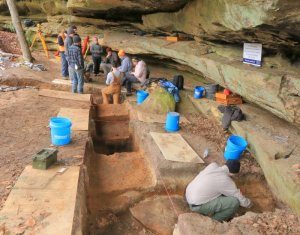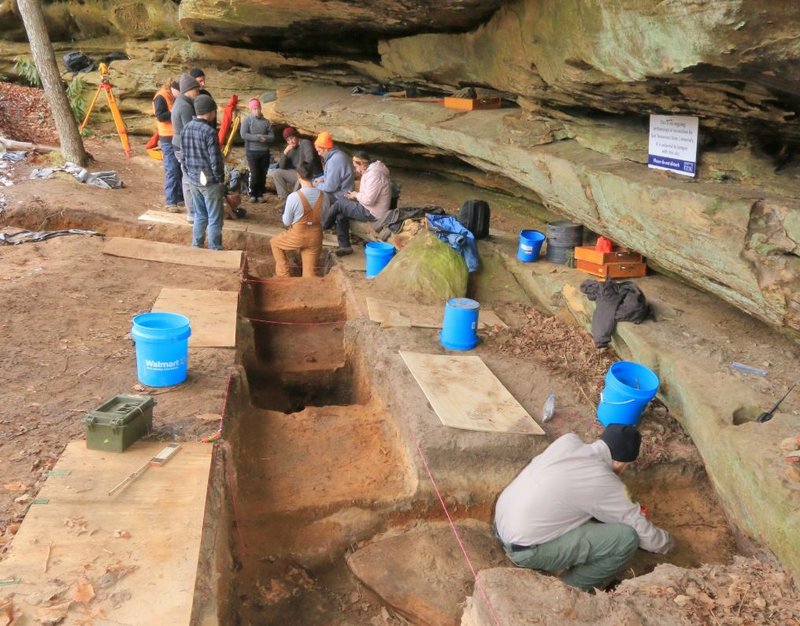
Upland areas, far from the more accommodating lowland environments featuring streams, lakes and valleys, have not been as comparatively rich in yielding evidence for early Native American, or Paleoindian, habitation—at least in terms of permanent, ongoing settlement bases. But archaeological excavations at a rock shelter in the Upper Cumberland Plateau (UCP) of Tennessee are revealing finds that could show otherwise.
“At Rock Creek Mortar Shelter on the UCP, we have recorded a more or less continuous record of human occupation from at least the end of the Pleistocene around 11,500 years ago to about AD 1000,” reports Jay Franklin, Associate Professor of Archaeology at East Tennessee University and colleagues. It is unusual because, as they report, “upland areas do not typically fit into conventional models of human settlement, except in cases where they are invoked as marginal areas used for hunting and gathering forays by ancient peoples only to return to their lowland homes.”*
Franklin has been conducting archaeological research in the UCP for well over a decade. At an elevation as much as 1,000 feet above the Tennessee River Valley, it comprises part of a larger region of Appalachia historically known as the “Great Wilderness”, a cultural backwater. But, for Franklin, this “could not be farther from the truth. Prehistoric Native Americans used and occupied these rock shelters and caves for 12,000 years.”*
From within the shelter, Franklin and his team recovered more than a dozen blades from deposits about 1.25 – 2 meters below the surface. They date them to the late Pleistocene and early Holocene periods. Examination of the blades has provided some clues to reconstructing the prehistoric scenario at the location. “A few of the well made blades would be at home in European Late & Epi-Paleolithic assemblages, while a few are poorly executed,” report Franklin and colleagues. “This suggests a family group as opposed to simply a group of male hunters. It may have been that older, skilled knappers were teaching younger novices to make blades on site. It may also be that these earliest inhabitants of the UCP were coping with the constraints of using the small rounded local cobbles of Monteagle Chert for blade production (as opposed to large tabular cherts encountered in the lower Tennessee River drainage).”
“So far, 50 tools/pieces have been analyzed for microscopic use wear,” Franklin continues. “Activities represented in the late Pleistocene/early Holocene levels include early stage hide and meat processing and scraping wood. Two tools possess some sort of residue which we think may be blood. We might tentatively suggest a temporary hunting camp occupied by residentially mobile families.”*
________________________________
 East Tennessee State University team hard at work at excavations at the Rock Creek Mortar Shelter site. Photo credit Alan Cressler.
East Tennessee State University team hard at work at excavations at the Rock Creek Mortar Shelter site. Photo credit Alan Cressler.
________________________________
Franklin plans to return to the site in December, 2014, to continue excavations. “We hope to recover blade cores in the coming field season so that we may reconstruct the entire blade production sequence,” he says. “More generally, we will continue to explore why these early people ventured onto this rugged, upland landscape far removed from a major stream and tens of kilometers from primary raw material sources.”*
More information about the Rock Creek Mortar Shelter excavation project, field school, and how one can participate, can be found here.
____________________________________________
*http://faculty.etsu.edu/franklij/etsu_archaeological_field_school_10.htm
____________________________________________
Travel and learn with Far Horizons.
Read about the most fascinating discoveries with a premium subscription to Popular Archaeology Magazine. Find out what Popular Archaeology Magazine is all about. AND MORE:
On the go? Get the smartphone version of Popular Archaeology as an app or as an ebook.
Popular Archaeology’s annual Discovery Edition eBook is a selection of the best stories published in Popular Archaeology Magazine in past issues, with an emphasis on some of the most significant, groundbreaking, or fascinating discoveries in the fields of archaeology and paleoanthropology and related fields. At least some of the articles have been updated or revised specifically for the Discovery edition. We can confidently say that there is no other single issue of an archaeology-related magazine, paper print or online, that contains as much major feature article content as this one. The latest issue, volume 2, has just been released. Go to the Discovery edition page for more information.







